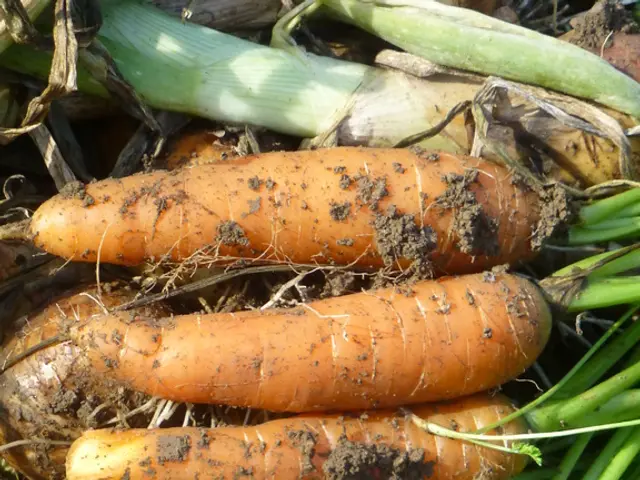Enhanced Crop Production Through Companion Planting: Quantifiable Growth in Yields
Companion Planting: A Time-Honored Practice to Boost Yields in Gardens and Farms
Growing a variety of plants together with specific, beneficial interactions in mind can result in higher yields and a more sustainable agricultural practice. This millennia-old method of companion planting is seeing a resurgence among gardeners and farmers seeking to reduce their environmental impact and cultivate a more biodiverse landscape.
Companion planting maximizes crop growth potential by exploiting plants' natural symbiotic relationships. Plants offer numerous advantages that contribute to healthy crops, such as pest management, pollination, soil improvement, and space optimization.
Enhanced Pest Management
Companion planting pairings, like basil, marigold, and garlic, naturally deter destructive pests with their distinctive scents. Flowers, such as nasturtium and dill, attract predatory insects that protect plants from unwanted pests, reducing the need for chemical pesticides that may harm the local ecosystem.
Improved Pollination
Flowers like borage, lavender, and sunflowers invite beneficial pollinators like bees and butterflies. These pollinators help with fruit and seed production, resulting in higher yields and better crop quality.
Better Weed Control
Species such as squash or clover prevent weed growth by shading the soil and hindering weed seed germination. This natural suppression of weeds lessens competition for nutrients and water, allowing your primary crops to thrive.
Space Utilization
Companion planting fosters an efficient use of available space, pairing plants thatCoexist well together rather than allocating a single square foot to each plant.
Soil Health Support
Plants like legumes enrich the soil by absorbing nitrogen from the atmosphere and fixing it in the soil, providing essential nutrients for nearby crops. Different plants draw nutrients from various soil depths, reducing depletion risks and promoting diverse soil health.
Deep-rooted plants like carrots help breakup compact soil, improving aeration and drainage. These amended growing conditions foster a more resilient and healthier crop ecosystem.
Promoting Biodiversity
A wide variety of plants in close proximity to one another form a more resilient mini-ecosystem. They attract beneficial insects, lower the risk of disease outbreaks, and improve the soil microbiome diversity for a more versatile and robust farming or gardening environment.
Higher Yields and Quality Produce
With adequate pest management, pollination, and nutrient resources, companion planting consistently yields higher overall crop levels. Some specific pairings even enhance the taste and quality of the accompanying crops, such as tomatoes and basil.
Reduced Chemical Dependency
Reduced reliance on fertilizers, pesticides, and herbicides results from companion planting. This method contributes to an environmentally friendly and sustainable agriculture system.
Understanding Companion Planting Considerations
The following aspects are essential to consider for optimal companion planting results:
- Ensure plant compatibility, as some plants compete for the same nutrients and space, potentially reducing yields rather than improving them.
- Allot time for additional planning and management to account for each plant's growth cycles, root structures, and nutrient requirements.
- Test local soil conditions, climate, and crop types before implementing companion planting at scale.
The Science Behind Increased Yields
Companion planting offers numerous underlying mechanisms behind its successful crop yields:
- Resource partitioning, in which shallow- and deep-rooted plants utilize available nutrients and moisture more efficiently.
- Pest and disease suppression, due to mutualistic effects among companion plants and the repelling power of certain herbs and flowers.
- Soil enrichment, as legumes help fix nitrogen in the soil and other plants adds organic matter.
- Microclimate modifications, which can improve growing conditions for shade-loving or heat-sensitive crops.
Calculating Potential Revenue Increases
By enhancing overall yields, companion planting has the potential to significantly boost a farmer's or gardener's income, as examined in a recent study comparing strawberry crop yields in monoculture versus polyculture plots:
- The polyculture gardens saw a 32% increase in total yield by weight compared to monoculture controls.
Consider a 1-acre vegetable farm with an average wholesale vegetable price of $2 per pound:
- A monoculture scenario would net $40,000 gross revenue per acre.
- A polyculture scenario could yield $52,800 gross revenue per acre, resulting in an additional $12,800 in revenue per acre.
These revenue increases, paired with the environmental benefits of companion planting, make it an appealing choice for those looking to grow their business while practicing sustainable agriculture.
Strategies for Optimized Companion Planting
To begin implementing this practice into your farming or gardening routine, consider the following strategies:
- Utilize the ancient "Three Sisters" technique, consisting of corn, beans, and squash, which delivers higher yields through the supportive structures, nutrient enrichment, and weed control this combination provides.
- Plant aromatic herbs like garlic, chives, or marigolds along field borders to deter pests and prevent their movement across crops.
- Take advantage of the flavorful and yield-enhancing relationship between tomatoes and basil.
- In larger spaces, adopt row intercropping, in which two crops are grown in alternate rows, to maximize yields. This setup minimizes competition for sunlight and nutrients while encouraging soil growth.
A Path to Sustainable Yield Growth
The numbers show us that companion planting, when executed strategically, contributes to sustainable business growth, both environmentally and financially. Implementing this traditional practice can provide significant advantages for those looking to minimize their environmental impact while maximizing their returns.
Following the Three Sisters technique, combining corn, beans, and squash in gardens or fields, offers higher yields due to the supportive structures, nutrient enrichment, and weed control provided by these crops.
Utilizing aromatic herbs such as garlic, chives, or marigolds along garden borders helps deter pests and hinder their movement across crops, contributing to a more sustainable gardening practice.








